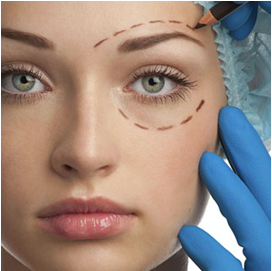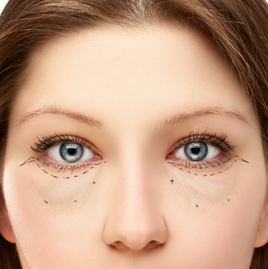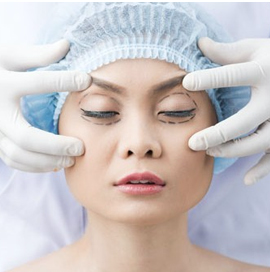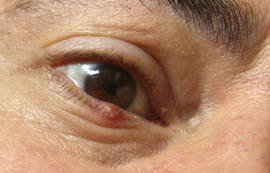
Cosmetic Blepharoplasty is North America’s most popular cosmetic procedure and is done to rejuvenate your “saggy and baggy” eyelids, leaving you with a refreshed and natural appearance. Why might you consider a cosmetic Blepharoplasty? This is what we hear our patients tell us every day:
“My eyelids make me look older than I feel.”
“People say I look tired.”
“I’m getting the same eyelids as Mom, (or Dad).”
“I don’t need glasses after my Lasik, but now people see my eyelids.”
“I can’t wear makeup anymore – it is always smudging.”
If you are not satisfied with the appearance of your eyes, you may wish to consider Blepharoplasty to reduce and remove the extra skin and fat (bags!!) from your upper and/or lower eyelids.
Are the eyes the “windows to the soul”? No one is sure about that, but your eyes tell a lot about you. If the image of your eyelids does not tell others how young and energetic you really feel, cosmetic Blepharoplasty may be the procedure for you. We can’t promise to take 20 years off everyone, for many of our patients are under 40, but we do want your eyes to look as good as possible to naturally communicate your own energy, vitality, and beauty.

Upper Eyelid Blepharoplasty
Surgery on the upper eyelid has been performed for many years, indeed, dating back to 1852, when Sir William Bowman operated on a child with a droopy eyelid (and this was in the days without anesthetic!). Many different problems are associated with the upper eyelids: true eyelid ptosis (droopy eyelid), dermatochalasis (extra or redundant eyelid skin and fat), eyebrow drooping, and the absence of the appropriate skin crease. Evaluation of the upper lid area includes the understanding of these features, as well as the understanding of the underlying eye and its physiology.
A true droopy eyelid, either from birth or from loss of the normal function of the eyelid anatomy, is generally correctable. Our doctors use dozens of different techniques to correct a true droopy eyelid, and generally this type of surgery, is appropriately covered by your provincial health insurance (like Alberta Health and Wellness).
Dermatochalasis, or “baggy eyelids”, is a common problem and often has a familial tendency. Very occasionally, it is apparent even in children, but generally becomes more common with increasing age. It is often exaggerated by a brow ptosis, the drooping or sagging of the eyebrow. The role of cosmetic blepharoplasty is to remove the excess skin, and to thin the eyelid in the appropriate areas by removing excess fibrous tissue and fat. It is the fat pockets within the upper eyelid that produce the “heavy bags”. This surgery has been done for many years and the CO2 Laser has added to its efficiency and safety. Generally, the appropriate amount of skin is excised and underlying tissues are thinned. It is important to take this in the context of safety and comfort of the eye – the upper lid needs to have adequate skin to have full and easy closure of the eye. Also, the brow position is very important in its contribution to the appearance of the eyelid.
Surgical Management of Upper Lid Bepharoplasty
Surgery of the upper eyelids for adults is almost always done under local anesthetic and is often combined with sedation. New intravenous medications given by specialist anesthetists, allow excellent comfort and relaxation, usually without the side effect of nausea. Both the CO2 Laser and more traditional surgical instruments can be used for surgery. This is where it shows a real value in the improvement in safety, comfort, and healing time. It is very important to recognize that there must be adequate upper lid skin left in place to maintain a normal and comfortable eye for the rest of one’s life. This procedure is often combined with a gentle brow lift to optimize results.
Recovery time is usually two weeks for bruising, return to strenuous activity, contact lens wear, and makeup. Additional time is needed for scars to settle and for swelling to dissipate.
What this procedure can and cannot do you for your eyelids, and how much tissue should be removed or lifted, is very individual depending on each person’s anatomy and eye health. During your consultation, it is important for your surgeon to understand your goals and for you to understand what you can expect as a result from surgery.

Lower Eyelid Blepharoplasty
Surgery on the lower lids has been performed for many years, and has generally been more problematic than upper lid surgery. However, over the last several decades, extensive knowledge has been obtained with respect to the surprisingly complicated lower lid anatomy and function. There are many different problems associated with the lower eyelids: there can be lower lid retraction (called sclera show – seeing the white beneath the colored part of the eye), dermatochalasis (extra or redundant eyelid skin and fat) and lower lid laxity – the loss of true tension and contact between the eyelid and the eye. The lower lid is not a simple fixed tissue, but rather it moves up and down with blinking and different positions of gaze, and it needs to have constant appropriate contact with the eyelid – like the wiper of the car windshield. Evaluation of the lower eyelid includes the understanding of these features, as well as the understanding of the underlying eye and its physiology.
Surgical Management of Lower Lid Blepharoplasty
Cosmetic surgery of the lower eyelids is almost always done under local anesthetic with intravenous sedation with a specialist anesthetist using new intravenous medications to allow excellent comfort and relaxation, usually without side effects like nausea. Both CO2 Laser and more traditional surgical instruments can be used to operate on the lower lid.
Two major options are available for lower lid blepharoplasty – and they are very different in goals, techniques, and recovery time. The two options are Transconjunctival blepharoplasty (with or without CO2 Laser Resurfacing) and External-Approach blepharoplasty. Recovery time is usually two to four weeks for bruising, return to strenuous activity, contact lens wear, and makeup. Additional time is needed for scars to settle and for swelling to dissipate.
- Transconjunctival Blepharoplasty is ideal for people who have lower lid “bags” or fat pockets but who have relatively smooth and tight skin. Extra fat pockets can be removed or repositioned, without even touching the skin. By repositioning or removing the fat from the hidden surface of the eyelid, there are no visible incisions or stitches. This is done primarily with CO2 laser.For people with mild amounts of extra skin particularly in the lower eyelids and ‘crows feet’ areas, CO2 laser skin resurfacing can be very useful, and is often combined with transconjunctival blepharoplasty to help tighten the skin. With laser skin resurfacing there is the ability to create younger, smoother and fresher skin by removing surface imperfections and reducing the lines and wrinkles. The laser reduces sun damaged and aging skin on a layer by layer basis with an accurate high energy beam of light: the laser.In recent years there has been a huge and confusing growth in different skin treatments. Non-surgical procedures [e.g. Botox, Collagen fillers, microdermabrasion, photo rejuvenation, micro Laser with Erbium, Thermage radiofrequency, photodynamic therapy, etc.], all have potential uses and indications. CO2 Laser Resurfacing when combined with CO2 laser transconjunctival blepharoplasty, is often still the best way to remove ‘bags’ or fat pockets of the lower lids at the same time as non-surgically tightening the eyelid skin.However, one of the disadvantages of CO2 laser resurfacing is the variable nature of the time period to full recovery. Sometimes redness lasts only a few weeks and occasionally it is frustratingly slow lasting a few months. (Fortunately, makeup can be used after 7-10 days). Also, it is important to avoid sun exposure. This is not a procedure for all skin types as some people can develop unwanted hyperpigmentation or darkening of the skin.
- External-Approach Blepharoplasty is necessary when skin, fat, or the whole eyelid, needs to be surgically tightened and repaired. It is very important to recognize that there must be adequate skin in the lower lid to allow closure and normal upward movements of the eyelid, and to keep good contact between eyelid and the eyeball – the windshield wiper effect. Depending upon the nature and health of every individual’s eyes this implies different amounts of skin resection and type of tightening to the lower lid. Without this knowledge and understanding of the underlying nature of the eyelid, the extent of the blepharoplasty cannot be accurately made. The concept of “how much eyelid surgery” has changed from how much does the surgeon take off, to how much does the surgeon leave – this is obviously more important than the amount that is removed.

Asian Eyelid Blepharoplasty
The creation of a specific skin crease is important in any eyelid. This is the upper lid skin fold. It is part of every ptosis procedure and its symmetry is important in any blepharoplasty. Also, it is often of specific interest to Asian patients. There are at least five different types of “typical” Asian eyelids, and some of these do not have a typical skin crease or fold. This can certainly be created in any Asian eyelid, although the specific height of the crease is often determined by the nature of the natural fold at the inside corner of the eyelid i.e. the epicanthal fold. It is important to realize that too high a crease can be unnatural, but with precise positioning within the eyelid a very natural and defined crease can be obtained.


